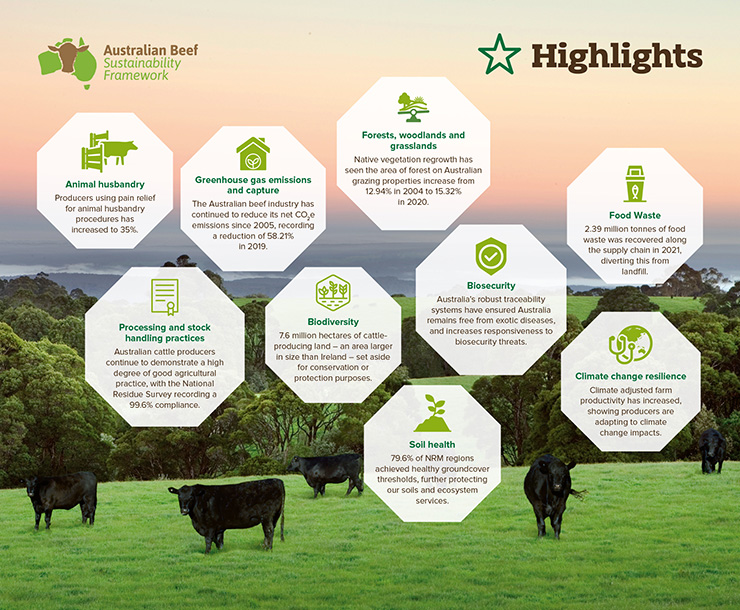The Framework Explained: 2022 Annual Update highlights
05 July 2022

Key points:
- The Update found significant improvements in carbon emission reduction and increased farm production amidst climate change
- Other highlights included increased use of accepted animal husbandry procedures and good agricultural practice, plus reduced wastage, and a robust biosecurity network
- Biosecurity threats, impacts of COVID-19, natural disasters and sourcing reliable data remain as challenges the industry must navigate going into the future.
The Australian Beef Sustainability Framework (ABSF) 2022 Annual Update has reported many positive developments in sustainability across the value chain.
Progress made for sustainability
The ABSF 2022 Annual Update has revealed the Australian beef industry has reduced its carbon emissions by 58.21 percent between 2005 and 2019.
The figure is a significant improvement on 2018 (49.92%), although drought conditions during the reporting period are likely to have had some had some impact given reduced herd numbers. Despite this, and the expectation this number will continue to fluctuate in coming years due to conditions and seasons, this trend shows the industry is on a pathway to reaching the ambitious target of carbon neutrality by 2030 (CN30).
Producers are also adapting to climate change impacts with climate-adjusted farm productivity increasing. At the same time, the area of forest on grazing properties has increased from 12.94 percent in 2004 to 15.32 percent in 2020.
A large area of cattle-producing land continues to be set aside for conservation and protection purposes – 7.6 million hectares or an area equivalent roughly to the size of Ireland. In terms of groundcover, 79.6 per cent of NRM regions achieved healthy groundcover thresholds, further protecting our soils and ecosystem services.
Good agricultural practices a standout positive
Other highlights of this year’s Annual Update included the proportion of producers using pain relief for animal husbandry procedures increasing from 30 to 35 percent and a high degree of good agricultural practice, with the National Residue Survey recording a compliance rate of 99.6 percent.
Food waste has been reduced, with 2.39 million tonnes of waste recovered along the supply chain in 2021 and diverted from landfill.
Australia’s robust traceability systems have also ensured the country remains free from exotic diseases, and responsive to any biosecurity threats.
Challenges still to face
In terms of challenges for the industry, outbreaks of disease in neighbouring countries has placed the spotlight on biosecurity and COVID-19’s impacts continue to linger, disrupting supply chains, increasing costs and creating labour shortages and delays. Natural disaster remains an ever-present threat as parts of the country succumb to fire, flood and severe drought, requiring urgent change in grazing schedules, and challenges for rebuilding.
The importance of sourcing reliable and robust data is another key issue but the Annual Update demonstrates the Australian beef industry is engaged in a continuous effort to improve its sustainability performance and to align with the changing expectations and desires of its stakeholders.
To download the full 2022 ABSF Annual Update go to www.sustainableaustralianbeef.com.au


